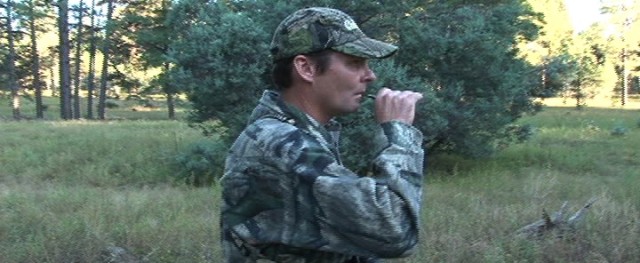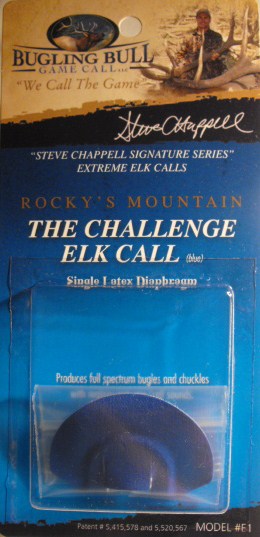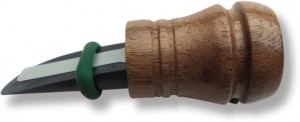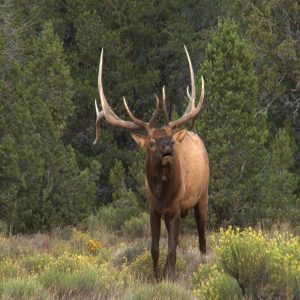Elk Calls 101
What to look for in a call and why

Now that I’ve been calling for a couple of decades, I hope to share with you some truths and tips about elk calls that I have come across through trial and lots of error! For the sake of this discussion, I am going to classify elk calls into these five categories:
1. Mouth Reeds (Diaphragm Calls)
2. Open Reed Calls
3. Bite and Blow Calls
4. External Reed Calls
5. Push Calls
I can still remember well the very first elk call that I purchased over 20 years ago in a small sporting goods store in Arizona. It was a Larry D. Jones mouth reed. I struggled like crazy to learn to use that call and no doubt, it was not the call’s fault – I was the weak link in the equation! It took me about a month to get a sound out of that mouth reed. I would certainly not consider myself a “natural”, just stubborn and determined!
This may seem a bit abrupt, or a cop out to some, but I am going to narrow down these 5 categories of calls to 2 to save you lots of time, money, and frustration. More importantly, only looking at these 2 classes of calls will help you become an effective, consistent elk caller. Here’s why; good mouth reeds and open reed calls posses the qualities necessary to produce better elk tones right out of the package when compared to the other 3 categories. What I am referring to is full, 3-dimensional tone quality, which I have found that elk respond incredibly well to.
If you have ever been around a very successful elk caller, I will guarantee you there’s one constant – they are either calling elk in with a mouth call or an open reed call. I’m talking about guys that call in boat loads of bulls every year on public land, not just the occasional dumb, young bull that will fall for about anything. If you listen to a great caller, their calling will sound 3-dimensional and “elky”, versus flat, thin, and 1-dimensional.
Mouth Reeds
 OK, now that we’ve narrowed down the call selection drastically, what do I specifically look for in a call? If it’s a mouth reed that I am shopping for, I prefer reeds that have a narrow frame width, and thus, a narrow latex span (width). So as not to confuse, I’m not talking about the tape width, but the frame width only. My reason for this is because a call with less latex width is naturally going to be easier to blow and require much less air pressure to achieve elk sounds. This is very important as it gives you the ability to blow the call loudly when desired, and also very softly when necessary. Another advantage is that calls that require less air pressure will last longer since you aren’t having to pound on them to get sound.
OK, now that we’ve narrowed down the call selection drastically, what do I specifically look for in a call? If it’s a mouth reed that I am shopping for, I prefer reeds that have a narrow frame width, and thus, a narrow latex span (width). So as not to confuse, I’m not talking about the tape width, but the frame width only. My reason for this is because a call with less latex width is naturally going to be easier to blow and require much less air pressure to achieve elk sounds. This is very important as it gives you the ability to blow the call loudly when desired, and also very softly when necessary. Another advantage is that calls that require less air pressure will last longer since you aren’t having to pound on them to get sound.
I prefer this narrow frame width even though I have a wide palate. Actually, the tape on the call is what creates the fit and the seal to the roof of your mouth, not the frame of the call. When choosing between calls with the same frame width, the differences will then become latex thickness, type, and latex tension when the call is manufactured.
Another factor will be whether the call has a “palate plate” or not. I much prefer palate plate style calls due to their tonal quality and ease of use. In my opinion, Rockie Jacobsen hit it out of the park when he invented this design. It is the most significant and lasting improvement to elk calls since they were first introduced to the market. My advice would be to start with a palate plate style call and experiment with several different reed designs to determine your preference.
At this point, let me say that it does not matter what a call is named or what the packaging says it is “intended” for. The only thing that matters is what does the call sounds like when YOU blow it. One person’s favorite bugling reed may very well be another’s best cow calling reed or vice versa! Listen to real elk anytime you get the opportunity, and use the call that you sound the most realistic on.
Remember when using a diaphragm call that you don’t want to use your lips to “say” anything into the call. Forget “Eei or Eeo”, etc. Rather control the tone with varying tongue pressure & position, and air volume – that is the key to mastering the mouth reed be it bugling or cow sounds. Keep the reed damp, and keep practicing – you will get it!
Open Reeds
 When it comes to open reed style calls, I am very picky and particular about what I like. Again, it’s not based on fancy names or marketing, but on the tonal quality only.
When it comes to open reed style calls, I am very picky and particular about what I like. Again, it’s not based on fancy names or marketing, but on the tonal quality only.
The first thing I have noticed over the years is that a more medium-to-wide width reed with proper thickness will produce a more nasally, 3-dimensional tone quality, which equates to a much better response from the bulls. When I look for a quality open reed call I am narrowing it down to those that are designed to sound “full” and nasally vs. squeaky and 1-dimensional due to a skinny reed. Skinny reeds sound better for predator calling – not elk calling.
The other factors of an open reed call that will influence the tonal quality are the barrel design and material, and the sound board design. Every caller’s lips and mouth are different so what works best for me may not necessarily be best for everyone else. Invest in a precious few and pick what sounds the best when compared to real elk.
There are a couple of important tips that will help get you started on open reed calls. As with a mouth call, you don’t want to “say” anything into the call as you blow. First, wrap your upper and lower lip around your teeth as if you are trying to hold dentures in your mouth. Then, with gentle lip pressure on the reed, bring air up from your stomach onto the reed to get sound out of the call. Once you are able to get sound, simply apply varying lip and air pressure to the call to get different tones and volume. More lip pressure equates to higher tones, where less pressure will give you deeper tones.
I will say that most people’s struggle with open reed calls comes primarily because they try too hard. If you tense up your facial muscles or put too much lip pressure on the call to start with, you will have a tough time mastering it. Relax, start with gentle lip pressure, and then go from there. One more thing I will add is that I personally do not slide the call in and out when I use it. I get varying tones by changing my lip pressure and air volume only.
In contrast to a mouth reed, moisture is your enemy with an open reed call. I keep my open reed call under a layer of clothing to keep it warm and do my best to keep saliva off of the call when blowing it. In very cold weather, I’ll even go to the extreme of keeping the call in a pocket with a hand warmer. By doing this, the call sounds better and is much less likely to stick on me when I need it most!
Grunt Tubes
 I don’t consider a grunt or bugle tube as an elk call “type” since it doesn’t produce sound without a mouth reed or your voice added to it. However, your choice of grunt tube will dramatically influence how your bugling, chuckles, and grunts sound with a mouth reed. After years of trying various types of tubes and some external reed bugle calls, I finally found and now prefer the “Bully Bull” tube by Bugling Bull Game Calls.
I don’t consider a grunt or bugle tube as an elk call “type” since it doesn’t produce sound without a mouth reed or your voice added to it. However, your choice of grunt tube will dramatically influence how your bugling, chuckles, and grunts sound with a mouth reed. After years of trying various types of tubes and some external reed bugle calls, I finally found and now prefer the “Bully Bull” tube by Bugling Bull Game Calls.
My reason for this is simple; the tube, when combined with a mouth reed, creates excellent elk-like resonance due to it’s design. By design, this tube creates “back pressure” which is THE MOST important element when bugling with a mouth reed to create 3-dimensional elk tones. While the tube may appear to be large and cumbersome, it is actually light and very easy to carry with the included lanyard. If your goal is to sound elk-like out there, the Bully Bull should be at the top of your list!
Calling is just like any other skill. It takes lots of practice and determination to master. I promise you, however, if you spend your time practicing on mouth reeds and open reeds, your dedication and hard work will be rewarded with big bulls coming to your calls. If your wife doesn’t like your “house calling”, go out in the garage or outside to practice! Lastly, remember you don’t have to be a “natural” to become a great elk caller!
Good luck on your elk hunts this fall and call em’ in close!
Visit the Elk101.com Store for a complete selection of quality elk calls!
